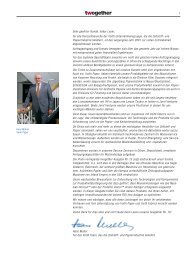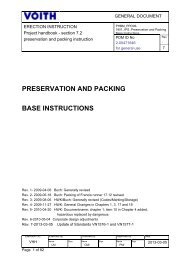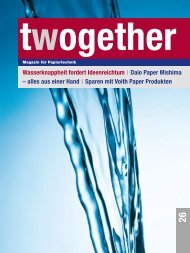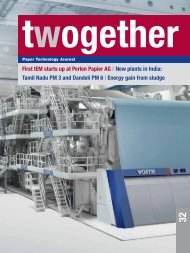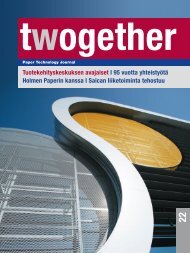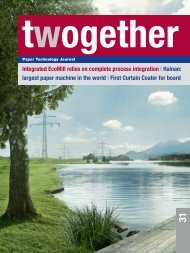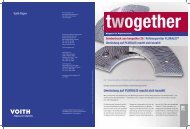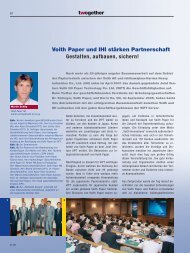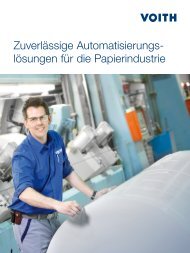Paper Technology Journal 19 - Voith
Paper Technology Journal 19 - Voith
Paper Technology Journal 19 - Voith
You also want an ePaper? Increase the reach of your titles
YUMPU automatically turns print PDFs into web optimized ePapers that Google loves.
Fig. 1: Procedure for a WEP Analysis.<br />
Procedure for solving product quality problems,<br />
e.g. basis weight and ash content fluctuations<br />
Periodic fluctuations Stochastic variations<br />
Pressure pulsation<br />
Mechanical<br />
vibrations<br />
Speeds and<br />
speed variations<br />
<strong>Paper</strong> transmission and<br />
quality control system<br />
Analysis<br />
in frequency<br />
range<br />
(Fourier<br />
spectra)<br />
The approach and evaluation method of<br />
the Wet End Process Analysis explained<br />
here shows that it is a largely standardized<br />
service product developed by <strong>Voith</strong> in<br />
close partnership with the paper industry.<br />
Goals of Wet End Process<br />
Analysis<br />
Since the Wet End Process Analysis is<br />
largely standardized, it serves as a tool<br />
for various purposes:<br />
It can be used for troubleshooting problems<br />
such as bad sheet profile or wrinkles.<br />
Time signal<br />
analysis<br />
(statistics<br />
and<br />
distribution)<br />
<strong>Paper</strong> laboratory tests<br />
e.g. Tapio analyzer (Fig. 3)<br />
Pressure pulsation<br />
Stock/ash samples and<br />
stock consistency variations<br />
Process control system<br />
(raw signal registration)<br />
Gas content, temperature,<br />
pH-value, conductivity<br />
This tool can also be used as a condition<br />
analysis prior to rebuilds or for assessing<br />
optimization potential and investment,<br />
e.g. to increase runnability or operating<br />
speed or better profile quality.<br />
The results from a Wet End Process<br />
Analysis by <strong>Voith</strong> Process Solutions are<br />
the basis for answers to various questions.<br />
The analysis in the paper mill consists of<br />
on-site measurements of all parameters<br />
affecting the papermaking process, production<br />
output and quality. Thanks to sophisticated<br />
evaluation techniques, conclusions<br />
can then be drawn on widely<br />
varying aspects.<br />
<strong>Voith</strong><br />
Process<br />
Solutions<br />
Wet End Process<br />
Analysis<br />
49<br />
Fig. 1 shows the basic procedure for a<br />
Wet End Process Analysis evaluation.<br />
Starting with the paper characteristics,<br />
such as basis weight or ash content stability,<br />
potential periodic or stochastic<br />
variation parameters are identified and<br />
evaluated. Interrelationships for example<br />
between pulsation and rotational frequencies,<br />
gas content and defoamers and<br />
sheet breaks are investigated thereby using<br />
all available information from the<br />
process.<br />
Typical aspects related to the<br />
papermaking process<br />
● Hydraulic stability (freedom from<br />
pulsation) of the stock and water loops<br />
● Inflow and outflow conditions as well<br />
as headbox pressure stability<br />
● Stock mixing efficiency among the<br />
various flows in the approach flow<br />
section<br />
● Efficiency-optimized operating ranges<br />
of the cleaner and screen sections<br />
● Optimized positioning of pipe elbows<br />
and fittings<br />
● Necessity and efficiency of mechanical<br />
degassing systems in relation to<br />
chemical defoamers<br />
● Additive quality in relation to gas<br />
content and retention of fiber and ash<br />
● Stability of the jet impingement line<br />
after the headbox; web pick-up<br />
deviations on the central press roll<br />
● Drainage element and vacuum settings<br />
for optimal quality and water removal<br />
<strong>19</strong>/05



